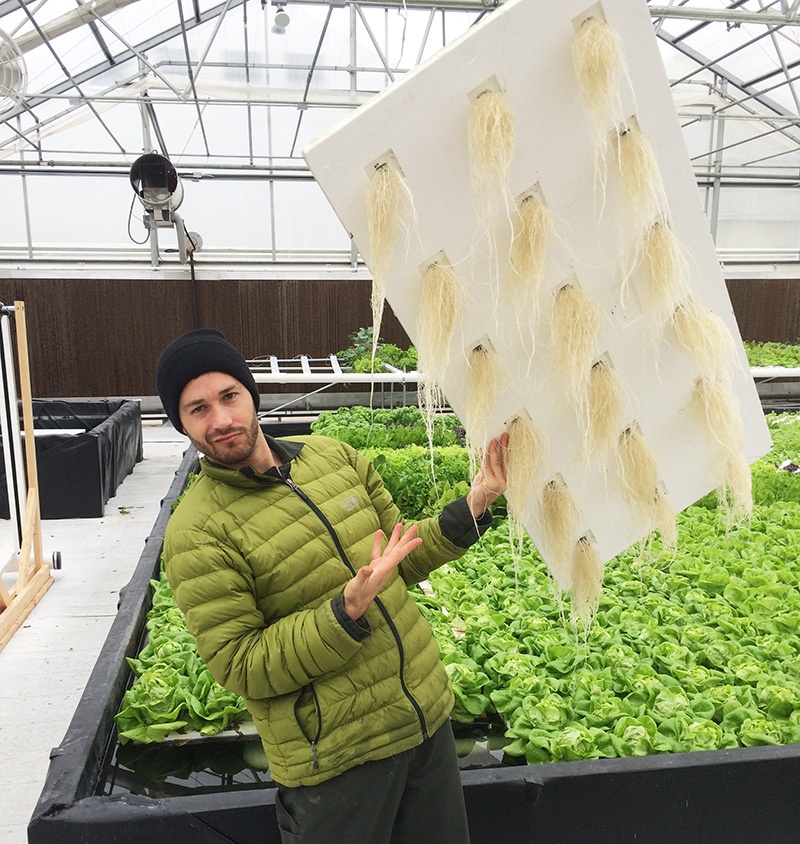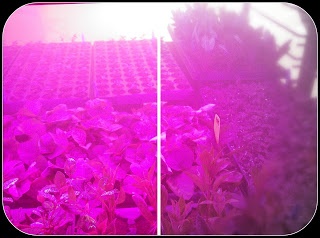
Substrate trials in Hort Americas’ research greenhouse are looking at conventional and organic propagation substrates along with different irrigation strategies for producing healthy starter plugs for hydroponic production systems.
Hort Americas has retrofitted a 12,000-square-foot greenhouse in Dallas, Texas, for the purpose of studying edible crop production in a variety of hydroponic production systems. The greenhouse is also being used to demonstrate products offered in the company’s online catalog.
Tyler Baras, who is the company’s special projects manager, is overseeing the trialing of conventional and organic substrates in different production systems.

Photos courtesy of Tyler Baras, Hort Americas
“The trials I am focusing on are organic substrates vs. conventional substrates,” Baras said. “I’m primarily using stonewool or rockwool as the conventional propagation substrate. I am also starting to trial some loose substrates, including peat and perlite.
“The seedlings are never moved into another substrate. The seed is sown into plugs and then the rooted seedlings are moved into a deep water culture, NFT (nutrient film technique), or vertical tower production system. The plugs are really only useful for the first two weeks in propagation. Then it is really about getting the roots to grow outside the plugs so the roots grow directly in the water.”
For the organic production systems, Baras is working primarily with expandable coco plugs. He has also started working with some organic loose substrates including coco peat and perlite.
For the substrate studies Baras is working with two standard hydroponic crops, basil and lettuce, primarily butterhead lettuce.
“When I’m testing the lettuce I use either raw or pelleted seed,” he said. “With basil it’s all raw seed. Basil tends to germinate relatively easily, whether the seed is planted into a dibbled hole or sown on top of the substrate.”
Focused on irrigation strategies
A primary objective of the substrate trials is to determine the best irrigation strategies for both organic and conventional substrates.
“This is probably more important with some of the organic substrates than the conventional substrates because the organic substrates tend to hold more water,” Baras said. “One of the big challenges that organic hydroponic growers run into is overwatering their plugs because coco holds more water than conventional substrate plugs that growers are used to. Coco plugs hold more water than stonewool, phenolic foam and polymer-based peat plugs. These other plugs dry out faster than coco plugs.”

Baras said growers who are moving from conventional to organic production tend to use the same irrigation techniques they employed with their conventional propagation program.
“The growers will continue to irrigate the plugs a couple times per day,” he said. “With a lot of the organic plugs, when the seed is sown, they only need to be irrigated once every three days. If the plugs are overirrigated the roots don’t have an incentive to search out the water when they are planted into the production system. The search for water is what drives the seedling roots down to the bottom and out of the plugs.
“The goal of planting into plugs is to have the seedling roots grow outside of the plugs into the water of the deep water culture or NFT system. If the plugs are overwatered as young seedlings, the roots don’t make it down to the bottom of the plugs so it takes longer to start the seedlings and sometimes they just end up rotting because the plugs remain too wet.”
Type of irrigation system
In addition to looking at the irrigation frequency of plugs during propagation, Baras is studying the impact of different methods of irrigation during propagation, including overhead and subirrigation.
“When deciding whether to use overhead or subirrigation, it depends on whether raw or pelleted seed is being sown,” he said. “If pelleted seed is going to be used, a lot of times it’s advantageous to use overhead irrigation because it helps to dissolve the coating surrounding the seed. This helps to ensure the seed has better contact with the substrate. Sometimes it’s almost a little easier to get good germination with subirrigation if raw seed is used because of the direct contact with the substrate.

“Smaller indoor growers often use subirrigation for germination. A lot of the large growers, especially those coming from the ornamental plant side such as bedding plants, usually have overhead irrigation systems installed. These growers have propagation areas set up with overhead irrigation, which can be used to start their hydroponic vegetable crops.”
Baras said most indoor warehouse growers are not going to be using watering wands or overhead irrigation in their operations.
“Most of the warehouse growers will be using subirrigation, such as flood tables,” he said. “For them it is going to be important that they select the right kind of seed to get good germination. They may have to try other techniques like using a deeper dibble or covering the seed with some kind of loose organic substrate such as perlite or vermiculite. Growers using overhead irrigation can usually sow pelleted seed without having to dibble the substrate.
“Many growers tend to have issues when they are using pelleted bibb lettuce seed with subirrigation. We are looking at ways of increasing the germination rate using dibbling with the pelleted seed or increasing the dibble size or covering the seed.”
Baras said growers who are using automation, including mechanized seeders and dibblers, prefer to use pelleted seed.
“With pelleted seed it’s easier to be more precise so that there is only one seed planted per plug cell,” he said. “I have seen automation used with raw basil seed. I have also seen organic production done where automation was used just to dibble the plug trays. Dibbling seems to be one of the biggest factors when it comes to getting good even germination.
Need for good seed-substrate contact
Baras said occasionally with tightly packed coco plugs, if the seed is not pushed down into the plug the emerging radicle may have issues penetrating the substrate.
“This helps push the radicle down so it contacts the substrate and establishes more easily,” he said. “When subirrigation is used it can be advantageous to cover the seed with vermiculite or just brush the top of the coco plug after the seed is planted to get some coverage of the seed.
“What usually affects the way that coco plugs work is the size of the coco particles. There is really fine coco. There is coco fiber, which can be mixed into the plug to help with aeration and increase drainage. We are looking at various plugs with some increased fiber content trying to aerate the plugs in order to speed up the drainage.”

Baras is also looking at using loose substrates in different ratios in plugs and then transplanting them into deep water culture, NFT, and vertical tower systems.
“One of the issues with hydroponic systems and loose substrates is these substrates can enter the production system and clog up the irrigation lines,” he said. “The trick is trying to avoid having any loose substrate enter the system. We are looking at using loose substrates and allowing the seedlings to establish longer in the plug cell during propagation before transplanting them into the production system. This enables the seedlings to develop a larger root system, which can prevent loose substrate from falling into the system.”
For more: Hort Americas, (469) 532-2383; https://hortamericas.com.
David Kuack is a freelance technical writer in Fort Worth, Texas; dkuack@gmail.com.








You must be logged in to post a comment.